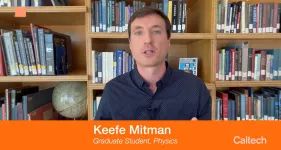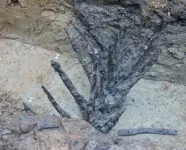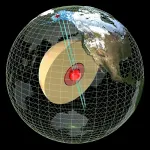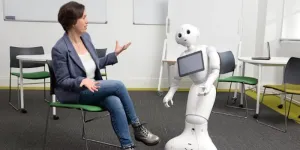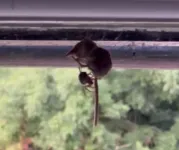(Press-News.org)
When two black holes collide into each other to form a new bigger black hole, they violently roil spacetime around them, sending ripples called gravitational waves outward in all directions. Previous studies of black hole collisions modeled the behavior of the gravitational waves using what is known as linear math, which means that the gravitational waves rippling outward did not influence, or interact, with each other. Now, a new analysis has modeled the same collisions in more detail and revealed so-called nonlinear effects.
“Nonlinear effects are what happens when waves on the beach crest and crash” says Keefe Mitman, a Caltech graduate student who works with Saul Teukolsky (PhD ’74), the Robinson Professor of Theoretical Astrophysics at Caltech with a joint appointment at Cornell University. “The waves interact and influence each other rather than ride along by themselves. With something as violent as a black hole merger, we expected these effects but had not seen them in our models until now. New methods for extracting the waveforms from our simulations have made it possible to see the nonlinearities.”
The research, published in the journal Physical Review Letters, come from a team of researchers at Caltech, Columbia University, University of Mississippi, Cornell University, and the Max Planck Institute for Gravitational Physics.
In the future, the new model can be used to learn more about the actual black hole collisions that have been routinely observed by LIGO (Laser Interferometer Gravitational-wave Observatory) ever since it made history in 2015 with the first direct detection of gravitational waves from space. LIGO will turn back on later this year after getting a set of upgrades that will make the detectors even more sensitive to gravitational waves than before.
Mitman and his colleagues are part of a team called the Simulating eXtreme Spacetimes collaboration, or SXS. Founded by Teukolsky in collaboration with Nobel Laureate Kip Thorne (BS ’62), Richard P. Feynman Professor of Theoretical Physics, Emeritus, at Caltech, the SXS project uses supercomputers to simulate black hole mergers. The supercomputers model how the black holes evolve as they spiral together and merge using the equations of Albert Einstein’s general theory of relativity. In fact, Teukolsky was the first to understand how to use these relativity equations to model the “ringdown” phase of the black hole collision, which occurs right after the two massive bodies have merged.
“Supercomputers are needed to carry out an accurate calculation of the entire signal: the inspiral of the two orbiting black holes, their merger, and the settling down to a single quiescent remnant black hole,” Teukolsky says. “The linear treatment of the settling down phase was the subject of my PhD thesis under Kip quite a while ago. The new nonlinear treatment of this phase will allow more accurate modeling of the waves and eventually new tests of whether general relativity is, in fact, the correct theory of gravity for black holes.”
The SXS simulations have proved instrumental in identifying and characterizing the nearly 100 black hole smashups detected by LIGO so far. This new study represents the first time that the team has identified nonlinear effects in simulations of the ringdown phase.
“Imagine there are two people on a trampoline,” Mitman says. “If they jump gently, they shouldn’t influence the other person that much. That’s what happens when we say a theory is linear. But if one person starts bouncing with more energy, then the trampoline will distort, and the other person will start to feel their influence. This is what we mean by nonlinear: the two people on the trampoline experience new oscillations because of the presence and influence of the other person.”
In gravitational terms, this means that the simulations produce new types of waves. “If you dig deeper under the large waves, you will find an additional new wave with a unique frequency,” Mitman says.
In the big picture, these new simulations will help researchers to better characterize future black hole collisions observed by LIGO and to better test Einstein’s general theory of relativity.
Says co-author Macarena Lagos of Columbia University, “This is a big step in preparing us for the next phase of gravitational-wave detection, which will deepen our understanding of gravity in these incredible phenomena taking place in the far reaches of the cosmos.”
The study titled “Nonlinearities in black hole ringdowns,” was funded by the Sherman Fairchild Foundation, National Science Foundation, the Innovative Theoretical Cosmology Fellowship of Columbia University, the Department of Energy, and the Simons Foundation. Other Caltech authors include Sizheng Ma, Yanbei Chen, Nils Deppe, François Hébert, Jordan Moxon[KSL1] [WC2] , and Mark Scheel. Additional authors include Leo Stein (BS ’06), Lam Hui, Lawrence Kidder, William Throwe, and Nils Vu.
END
Data captured from seismic waves caused by earthquakes has shed new light on the deepest parts of Earth’s inner core, according to seismologists from The Australian National University (ANU).
By measuring the different speeds at which these waves penetrate and pass through the Earth’s inner core, the researchers believe they’ve documented evidence of a distinct layer inside Earth known as the innermost inner core -- a solid “metallic ball” that sits within the centre of the inner core.
Not long ago it was thought Earth’s structure was comprised of four distinct layers: the crust, the mantle, the outer core and the inner core. The ...
In a bid to understand why mosquitoes may be more attracted to one human than another, Johns Hopkins Medicine researchers say they have mapped specialized receptors on the insects’ nerve cells that are able to fine-tune their ability to detect particularly “welcoming” odors in human skin.
Receptors on mosquito neurons have an important role in the insects’ ability to identify people who present an attractive source of a blood meal, according to Christopher Potter, Ph.D., associate professor of neuroscience at the Johns Hopkins University School of Medicine. “Understanding ...
Computer scientists at the University of Pennsylvania School of Engineering and Applied Science have designed a “reconstruction attack” that proves U.S. Census data is vulnerable to exposure and theft.
Aaron Roth, Henry Salvatori Professor of Computer & Cognitive Science in Computer and Information Science (CIS), and Michael Kearns, National Center Professor of Management & Technology in CIS, led a recent PNAS study demonstrating that statistics released by the U.S. Census Bureau can be reverse engineered to reveal ...
Woods Hole, Mass. (Feb. 21, 2023) -- When the Covid-19 pandemic hit in 2020 with associated travel restrictions, Matthew Long thought his students could shift their overseas research projects to instead study the seagrass meadow ecosystem in Waquoit Bay. It’s a shallow, micro-tidal estuary on the south side of Cape Cod in Massachusetts, near the Woods Hole Oceanographic Institution (WHOI) where Long is an associate scientist in the Marine Chemistry and Geochemistry Department.
However, when Long and his students looked for seagrass meadows where he had seen them in previous years, there were only a few shoots of dying Zostera marina eelgrass, ...
Bethesda, MD (Feb. 21, 2023) — In new evidence-based guidelines, the American Gastroenterological Association (AGA) recommends non-invasive biomarkers as a first-line strategy for monitoring many patients with ulcerative colitis (UC). These guidelines were published today in Gastroenterology.
The AGA guidelines outline use cases for three biomarkers that provide accurate insights into ulcerative colitis disease activity: serum C-reactive protein (CRP) (blood), fecal calprotectin (stool) and fecal lactoferrin (stool).
“For decades we have regarded endoscopy as the gold ...
Kai Ni was awarded a National Science Foundation CAREER Award to improve computing memory through the use of ferroelectric materials and capacity.
The assistant professor of electrical and microelectronic engineering in RIT’s Kate Gleason College of Engineering, Ni has been at the forefront of advancing ferroelectric memory, a familiar but never widely adopted technology that has the potential to meet the growing demand for more energy-efficient computing performance.
“The appetite for semiconductors just keeps growing. With the data we are generating every day, we need ways to process ...
Philadelphia, February 21, 2023 – Researchers from Children’s Hospital of Philadelphia (CHOP) developed two new zebrafish models for studying a specific genetic form of mitochondrial disease that represents the most common cause of Leigh syndrome. Using these models, the team identified two drugs already approved by the Food and Drug Administration (FDA) for other conditions that could be repurposed to treat this specific cause of Leigh syndrome. The findings were recently published in the journal Human Molecular Genetics.
SURF1 deficiency ...
Public lecture: how can we have a good future with artificial intelligence?AI expert and educator Professor Anikó Ekárt to discuss one of today’s most provocative topics
Lecture will take place on 28 February at Aston University
Talk to explore artificial intelligence’s capabilities, benefits and pitfalls.
The potential impact of artificial intelligence (AI) on our daily lives will be explored in a public lecture at Aston University.
The University is inviting the public onto its campus on Tuesday 28 February to hear Professor ...
A new study underscores the role that parents play as a safety net for their young adult children as those children navigate the labor market, and highlights the challenges facing young adults who do not have access to parental support.
“In recent decades, we’ve seen a lot of changes in the labor market, from the decline of lifetime employment at one job to the rise of the so-called ‘gig economy,’” says Anna Manzoni, corresponding author of the study and an associate professor of sociology at North Carolina State University. “We wanted to see what role ...
Scientists at University of Galway have published the first record of a noble false widow spider feeding on a pygmy shrew, a species of tiny mammal protected in Ireland.
The new study, recently published in the international journal Ecosphere, demonstrates further the potentially negative impact of the invasive and venomous noble false widow spider on native species.
A recording by Dawn Sturgess showing the spider interacting with the pygmy shrew be downloaded at https://bit.ly/3XPbDKU.
It is the first time a member of this family of spiders, ...
